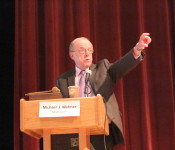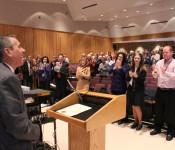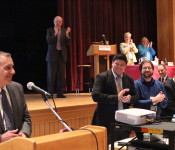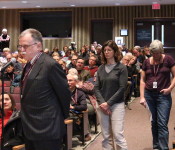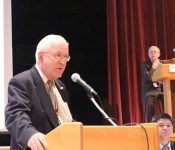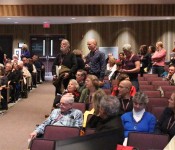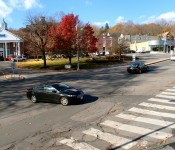Special Town Meeting Passes Article Urging Return of ‘Original’ Center Design
Photo: Gi Yoon Huang, Paul Roberts, Bonnie Friedman, Jack Weis and a resident celebrating the “yes” vote at Special Town Meeting.
Setting aside concerns it was descending a “slippery slope” of interfering with town governance, the Belmont’s Town Meeting members declared Thursday night, Aug. 6, that its opinion would be heard.
At the end of the three-and-a-half hour session, the Special Town Meeting passed a citizen’s petition, 112 to 102 (with 4 abstentions) to “urge” the Board of Selectmen to reconsider its decision on May 28 making significant changes to the Belmont Center Reconstruction Project.
Those changes included the retention of a cut through road between Concord Avenue and Moore Street and including parking spaces to a location originally set aside for the creation of a new “Town Green” in front of the Belmont Savings Bank.
“We’re all thrilled and relieved that Town Meeting voted in favor of the original plan,” said Paul Roberts, who with Bonnie Friedman, led the petition effort.
“I think this was really a vote about respecting the process in how we do big projects in town,” he said.
While the article is non-binding – and there is an indication the selectmen will not change its earlier decision when they meet on Aug. 17 – those on both sides of the debate said the vote will almost certainly affect how Town Meeting takes up capital projects from now on.
“In the future, [Town Meeting is] going to be very clear that we are only funding a particular plan and if there are any major design changes, you have to come back to Town Meeting,” said Friedman.
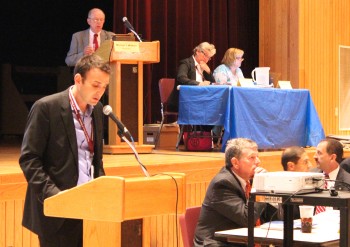
Paul Roberts addressing Town Meeting.
With Belmont expected in the next few years encounter several large capital projects before Town Meeting and voters – including a skating rink, new high school and a Department of Public Works headquarters – the Board of Selectmen is not eager to see another confrontation with the members on design issues.
“The lesson we learned is that when we come to Town Meeting with a project, we should be as close to finalized as possible,” said Selectman Mark Paolillo.
“Appropriation is really based on a design because we are asking for the money for a specific plan. This project was 90 percent designed when the funding was attached and we kept hearing that we needed a meeting to address concerns of our seniors,” said Paolillo, who said he did not regret his vote making the late minute change to the project.
In 2014, incorporating the work of the Traffic Advisory Committee and other groups, the Board of Selectmen OK’d for the town’s Office of Community Development created plans making up the $2.8 million reconstruction project. At the Nov. 17, 2014, Special Town Meeting, the members approved by a margin of five votes a $2.8 million financing plan for the project based on the designs presented.
Several residents at the time had questions concerning the design, specifically the loss of nine existing parking spaces adjacent to the front of Belmont Savings Bank and the so-called access road running in front of the bank.
Despite a promise to have a community meeting to discuss the issues in the winter before bids were accepted, the gathering did not occur until the May 28th meeting after a petition from Washington Street’s Lydia Ogilby with 200 signatures was presented to the board asking to save a grove of trees (which had already been taken down) and the drive through.
Despite both the selectmen and public viewing the new plan that evening and with construction already underway, the Selectmen voted to re-establish the roadway and add four parallel parking spots as a courtesy to seniors.
The resulting change prompted angry supporters of the original design to circulate its petition – with nearly 400 residents – at first to secure a public meeting with the Selectmen before working towards calling a Special Town Meeting.
In a peace offering presented at the meeting, the petitioners sought to lower the temperature that the confrontation had produced in the past two months – Town Moderator Mike Widmer advised the members to “recognize and respect that we have honest difference and we honor those differences” by “taking a positive approach to our debate” – by swapping a single word from the original article, no longer “directed” but to “urged” the selectmen to reconsider its earlier vote since “nobody in this room wishes to rewrite the laws by which this town has long operated,” said Roberts.
Yet Roberts, in his opening remarks, said Town Meeting needed to be heard after weeks of laboring and lobbying to restore the original vision of the center.
“This Special Town Meeting is the last remaining option available to voters to make sure that a conversation that desperately needs to take place is not silenced,” he said.
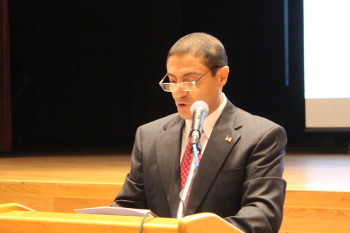
Belmont Selectmen Chair Sami Baghdady.
In response, Selectmen Chair Sami Baghdady reiterated the board’s contention the changes were well within its rights to alter the design as the board, under the town bylaws, has oversight control over such capital projects.
“Our decision is what we think is best for Belmont, Belmont residents, and the Center,” said Baghdady.
Rather than debate the issues of the competing plans, “I urge you to support the authority of the Board of Selectmen to do its job,” said Baghdady.
For supporters of the petitioners, the debate was fought on two levels; design and process. For Gi Yoon Huang, a mother of two young children, the original blueprint would create a green space protected from traffic in which people could use for passive activities such as eating lunch, taking a break, relaxing; a community space that draws residents into the location.
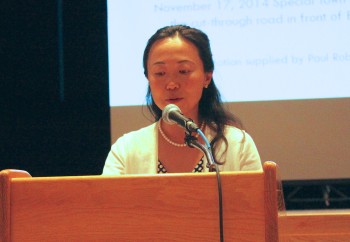
Gi Yoon Huang.
“Plan A can become a vibrant and vital part of the community where people can spontaneously gather and provide energy … to the community. Plan B will be a dead space,” said Yoon Huang.
Jack Weis said while the board appears to have the authority to make the change from plan A to B, members was told at the November’s Special Town Meeting the design was “90 percent complete” with only inconsequential “nonmaterial modifications” remaining as it approved the financing.
“[T]o insert new traffic circulation and reduce the amount of green space that was a stated key objective, that now constitutes a material change,” said Weis, stating Town Meeting members would have voted that plan down back in November.
“Regardless, if you think Plan A or Plan B is better, it’s important to respect what Town Meeting approved … and we ought to give the benefit of the doubt to the plan that was the result of years of discussion and analysis as oppose to 90 minutes of discussion at a Board of Selectmen meeting,” said Weis.

Town Meeting.
For those supporting the alternative, the selectmen’s acceptance of Plan B was the culmination of a promise by the Board and Town Meeting to hear and judge the concerns from the a segment of Belmont’s elderly.
Resident Joel Semuels, who serves on the Council on Aging, said the council never had the opportunity since the November meeting to “raise the facts” of safety and accessibility that the COA felt was not fully investigated by town officials and committees.
Paolillo reiterated his support for the alternative plan as “being what’s best for the overall community. It’s not where or not I agree or disagree with Town Meeting.”
Other members, while amenable to either plan, protested the notion Town Meeting has the authority to press the Selectmen to alter their opinion.
“The process for me is far more important to me than [the selected plan],” said Bob McLaughlin.
“The Board of Selectmen get elected; they do their job. If you don’t like, talk to them in April [when Town Election is held],” he said.
“If a camel is a horse designed by a committee, what’s the horse going to look like if this is the way we run our town government?” asked McLaughlin.
When the vote was taken, and the outcome revealed, the petitioners felt Town Meeting had revealed to the selectmen the direction it wants the reconstruction to proceed.
“We wanted nothing more than to show that major changes can not be done without Town Meeting oversight,” said Roberts.
Opinion: An Unfair Re-Do, Part Two
Photo:
This is the second half of an opinion article by Kevin Cunningham. The first half was published on Tuesday, Aug. 4.
“The traffic problem is solved”
It’s worth pointing out one other line of revisionist argument that is creeping into the discussion, this time on what to many is the most critical issue; the problem of traffic.
At the precinct meeting in September where the board laid out the general outlines of what would be voted in November, the very first comment from the public was a tempered lament that the proposed Belmont Center proposal did not in fact address the most visible problem of the Center; the tremendous traffic issue. Yes, the proposed project beautified the Center, but it left unsettled the commuter problem.
In response, Glenn Clancy, director of Belmont’s Community Development Office, noted that many efforts had been made to consider various options to address the issue, but he had to concede that traffic would still be an issue. Thus even from the outset it was understood that the Belmont Center Reconstruction Project did not solve the most significant problem the Center had: the massive traffic. Indeed, this was the grounds for many to not support it at Town Meeting, “You’re spending lots of money, but you’re not even solving the chief problem?”
Of course, the Center plan does address some of the traffic issues in a variety of ways: it does introduce traffic calming and makes certain intersections more rational, so the safety will be greatly improved. That is certainly a worthy and important goal. Nevertheless, the plan does not eliminate or reduce the traffic itself. Indeed, it eliminated some of the relief valves for traffic, in favor of safety. That’s understandable, but the traffic will still build up.
Thus, when the board voted on the revisions in May, it was not merely trying to address the parking issues of the elderly. It was even more significantly attempting to strike a compromise that did something to mitigate the unresolved traffic issue. It is an important issue, it affects all of us, and it is unfortunate that is it difficult to resolve. But the board took a stab at giving a balanced response to the issue.
Today, you will hear that the Center plan actually does address the traffic issue fully. If you dig under the rhetoric for this, however, you will basically see the following argument: “The Center redesign takes a major thoroughfare, which up to now has been shared by motorists and pedestrians, and reorients it toward pedestrians; drivers will consequently learn to stay away from this route because it will be even less favorable to them than before. Problem solved.”
This logic – “build it and they will not come” – may or may not be rational. But it certainly has not been established to be a majority opinion, nor even an idea that Town Meeting knew when it voted on funding the project. Rather, people understood, and were explicitly told, that the traffic problem was not solved by the proposed plan. To assert now that it was solved all along, and that everyone agrees with the logic and consequences of the traffic suppression approach, is simply unfounded.
“They are suppressing democracy”
One last point bears noting. The most recent line of argument that might be proffered by proponents of the new action, a line that will be emotionally convincing to many citizens but is still untrue, is that the board has now added insult to injury by pushing away properly organized groups of citizens and stifled their free expression. The board, it is claimed, has muzzled the citizens, called the cops on them, and perversely not listened to reason when it ought to have.
The board has done nothing of the kind. People intruded in venues that were not appropriate for raising their points, and the elected body properly said they were out of order. Now, there is indeed a problem in town about lack of venues in which to raise process points. But that doesn’t justify packing a hall with an intense and angry group of people and insist, against procedure, your right to be heard.
It is worth noting that, just because someone feels oppressed, it does not automatically follow that there is an actually an oppressor, especially an evil oppressor that is persistently acting to thwart their good intentions.
But all this obscures the key point. For the sake of argument, let’s say that the board is now stifling free speech. What has that to do with the Belmont Center decision? That decision was made last Spring, not this summer. The oppression being asserted now could not possibly have influenced the vote in Spring. It didn’t exist then. Certainly many people feel like their voices are being suppressed now, but it is not logically connected to the vote in May.
Now, some will argue that it is relevant, because they believe it shows some ongoing pattern of the Selectmen to skirt democracy. But here again, the proper followup to such an observation is to make the case to the proper authorities and get censure of the Board, not to create an elaborate proxy in the form of a Town Meeting vote on A versus B.
A fair vote is now impossible
In fact, this all inescapably clouds the vote at Town Meeting. Are we voting on A versus B, or instead indirectly defending Town Meeting’s prerogative? Or is all this really a referendum about whether the Board of Selectmen proceeded improperly, or, even further afield, whether they are proceeding oppressively now? What exactly is this vote about?
Unfortunately, this use of the vote as an unstated proxy for the latter cases, or for the earlier accusations of collusion, renders it now impossible for the Town Meeting vote to be conducted fairly. Nevermind that the actual intent of the vote is unclear. In any town where the publicity about a legal case has been too much filled with unsubstantiated rumors and accusations, our legal system has taken the prudent course of moving the trial to another district. The jury, we realize, could not help but be biased, even if they maintained and believed otherwise. We all know there is wisdom in that.
Town Meeting is in such a case now: we believe we can be fair, but too much has been said, too much emotional baggage is now being carried, so it is not actually possible to be free of it. Even if all the facts were reported accurately in Town Meeting, we are no longer in a position to view them with an unbiased eye. Too much has happened.
An unfair do-over
Where does all this leave us?
If you review the changing history of the case for the Belmont Center action, you will see only one constant: the proponents were unsatisfied with the results of a certain decision, and they want it changed.
It is entirely understandable that the proponents of the new action were disappointed by the Board vote. There are always those who don’t like the way some vote or other turns out. But to convert this into a moral crusade, vilifying fellow citizens and uncivilly interrupting the public business of elected officials as a means to reverse a perfectly legal decision, is entirely uncalled for, and has even made it impossible for them to get the result they want in an unbiased way. They may get the result, but it would not be fairly obtained.
The truth in this case is simple: the current campaign is simply an unfair attempt at a re-do of a vote that was properly made, a vote that was made with input from citizens and deliberation by thoughtful elected officials, and a vote that is not Town Meeting’s province to make in the first place nor in its jurisdiction to overturn. In support of this inappropriate re-do, proponents have put forth a variety of arguments, some unconvincing as best, some libelous, and many simply false, as to why it is appropriate to hold a new vote on the topic. But Town Meeting has no authority, moral or legal, to instruct the board on this matter, and all the hullaballoo is simply an unfair attempt to change history.
A do-over is improper, if it were even possible to conduct fairly – which it is not – and therefore should not proceed.
Kevin Cunningham
Town Meeting Member, Precinct 4
Special Town Meeting Petition on Belmont Center Delivered to Town Clerk
Photo: Town Clerk Ellen Cushman counting signatures.
It appears Town Meeting members will have to forego one summer night on the shore or lounging in the back yard after a group seeking to reverse a last-second change to the Belmont Center Reconstruction Project has delivered what they believe is the necessary number of signatures to Belmont’s Town Clerk this afternoon, Tuesday, July 7, to call a “special.”
Bonnie Friedman of Hay Road presented 302 signatures on a petition to Town Clerk Ellen Cushman who will begin certifying the names. At least 200 signatures from registered voters must be certified for the process to begin.
Under Massachusetts General Law (MGL 39 §10), a special town meeting must take place by the 45th day after the date of petition is submitted. According to Cushman, with the petition was received by her on July 7, the latest a Special Meeting could take place would be Aug. 21.
The petition was created by Cross Street’s Paul Roberts after the Board of Selectmen made two major changes to the $2.8 million Belmont Center Reconstruction Project some time after major construction began.
In May, the Board called a public meeting outside its regular schedule to hear from 96-year-old Lydia Ogilby of Washington Street who submitted her own petition that would protect a crop of trees in the center (which had already been chopped down) as well as keep a cut through from Moore Street to Concord Avenue adjacent Belmont Savings Bank.
The board approved keeping the byway and adding four parallel parking spots next to the bank. The changes left a much heralded “Town Green” located in front of the bank to be reduced to an island surrounded by roadway.
The project design had taken four years to develop under the tutelage of the Traffic Advisory Committee who held a number of public meetings to discuss the project.
Opposition to the Selectmen’s changes revolved around the vanishing “Green”, increased traffic and a view that the Board had overstepped its authority to make changes to a project which an earlier special town meeting in November 2014 approved the financing based on the finished blueprint.
An attempt by proponents of the original design to discuss the matter before the Selectmen resulted in a shout-filled brouhaha in which a police officer was called to oversee the meeting. The next day Roberts began seeking signatures.
The petition reads:
We, the undersigned registered voters of the Town of Belmont, Massachusetts, request that the Board of Selectmen of the Town of Belmont place an article on the Warrant for a Special Town Meeting to read:
“In proceeding with the Belmont Center restoration project, as approved and funded by Town Meeting on November 17, 2014, shall the Board of Selectmen and other Town officials be directed to adhere to the plan represented in the Belmont Center Improvements design documents put out to bid by the Town in January 2015, said documents based on the conceptual plan presented to Town Meeting in the November 2014 Special Town Meeting. These documents shall be used in place of the Board of Selectmen’s revised Belmont Center restoration conceptual plan, adopted unilaterally at a meeting held on May 28, 2015.”
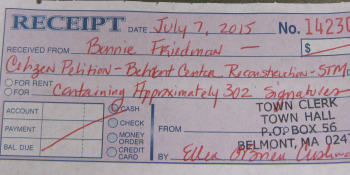
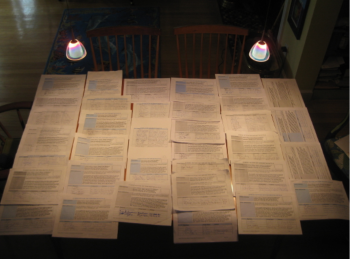
Special Town Meeting Approves $2.8 Million Belmont Center Project
Photo: Selectmen Chair Andy Rojas presenting the Belmont Center Reconstruction Project to the Special Town Meeting, Monday, Nov. 17.
In the end, Belmont’s Special Town Meeting decided a renovated Belmont Center was worth the $2.8 million price tag, no matter the funding scheme.
After more than three hours of presentation, analysis and debate, the Town Meeting members voted 140 to 63 to approve the project set to improve sidewalks, crosswalks, pavement repairs, allow for the installation of a new parking system and add new lighting in the town’s main business hub.
“It’s time that [the project] was approved,” said Belmont Selectmen Chair Andy Rojas who, with his fellow members, Mark Paolillo and Sami Baghdady, pushed for the vote this fall after nearly five years of studies and reports.
An initial timeline calls for construction to begin in late winter of next year with expected completion on Oct. 31, 2015.
The majority of the approximately 200 members who attended – about 70 percent of the representative members braved the elements on Monday, Nov. 17 to reach the Chenery Middle School – agreed with town’s elected official and staff who sought to finance the project with a one-time $1.3 million lump sum payment from the town’s “free cash” account and paying for a $1.5 million municipal bond out of the same “free cash” line item over the 15-year life of the debt.
Town officials convinced members the project’s financing options were similar to Goldilocks’ choices: at $2.8 million, the project’s financing was “too small” for a typical debt exclusion requiring a town-wide vote, yet was “too big” for the town’s capital budget to take on singlehandedly.
The funding source deemed “just right” was the town’s savings account which has reached historic levels.
“It’s not small but not terribly large,” said Belmont’s Treasurer Floyd Carman.
Free cash is unspent money remaining at the end of the fiscal year including from budget line-items and any greater than expected tax or fee receipts.
Officials turned to free cash that has been increasing steadily over the past five years, from $2.3 million in fiscal 2010 to $7.5 million in the coming fiscal 2016. This year, due to favorable fiscal conditions and other factors, the town received a large one-time injection into free cash of $1.3 million.
Carman said using free cash would not burden the town with new debt when at least $150 million of necessary projects – a new high school, a police station and a new Department of Public Works Yard – are looming down the road a few years.
“This is a balanced approach as we have one-time funds available,” said Carman.
Yet James Williams, Precinct 1, of Glenn Road submitted an amendment to the article requiring to town to finance the entire amount from a traditional sale of a 15-year municipal bond with its funding coming from general funds.
“Since this is a long-term project, it should be paid with long-term funds; I can’t understand doing it any other way,” said Williams, who voice the concerns of several members who felt queasy dipping into an account that previous town administrators and elected officials have been reluctant to use.
Williams said the funds could be better used “repairing the inaction of the past” in areas such as unfunded pension and retirement obligations leaving the town on shaky financial footings.
But town officials pushed back against the claims, calling the use of pension in the debate “a red herring.”
In addition, Carman said by going Williams’ route, the annual cost to the town would be $321,000 as opposed to $169,000 under the town’s proposal.
“Under Mr. Williams’ plan, we would need to either cut services or use free cash” to make up the difference, said Carman.
While several residents expressed support for the amendment, it was soundly defeated 153 to 49.
When the article with the town’s payment plan was brought up for debate, the discussion was a lively one, including how the project will not help in solving the traffic congestion that occurs during the morning and afternoon commutes.
Johanna Swift Hart, Precinct 4, Hull Street, said she “takes no pleasure” voting against the article. “[Belmont Center] is not a blighted neighborhood,” she said, noting the town has so many needs that officials should seek alternative sources to fund the project.
Belmont Center business owner Jeanne Widmer, Precinct 5, Gilbert Road, echoed others who contend that an upgraded Belmont Center will be a boom to the town’s economic future. She said surrounding towns such as Winchester, Lexington, Reading and Arlington have all made improvements to their downtowns to great acclaim.
“This is a modest plan,” said Widmer.
Town Meeting Amendment Challenges Belmont Center Project Financing Plan
Special Town Meeting just got a whole lot more interesting.
Rather than the option of simply accepting or rejecting the financing plan for the $2.8 million Belmont Center Reconstruction Project, the 290 Town Meeting Members now have an alternative to the town-created “free cash” proposal.
Read the project’s highlights here
James Williams of Glenn Road and Precinct 1 submitted an amendment to the Belmont Center warrant article that will be brought before the Special Town Meeting on Monday, Nov. 17 to bond the entire $2.8 million project using a traditional sale of a bond to be paid out of the general fund.
Under the plan submitted in the article, the town proposes to finance the project in two steps; an initial downpayment from the town’s free cash account – sometimes referred to as the town’s “savings account” – of $1.3 million and then issuing a $1.5 million, 15-year bond which will be paid for over the term of the debt from free cash.
Read about the unique way the town will pay for project here.
“Free cash” is typically actual town receipts in excess of revenue estimates and unspent amounts in departmental budget line-items at the end of the fiscal year, plus the unexpended free cash from the previous year.
Last week, the state’s Department of Revenue certified Belmont’s free cash amount at $7,465,000, an increase of $1.3 million from the previous fiscal year.
For Williams and others who both support and are opposed to the project, using the town’s “savings” to finance a capital project that will benefit the residents over many years is not the proper use of the funds.
At a warrant briefing earlier this month which reviewed the articles on the Special Town Meeting, town officials said the current plan “strike a balance” in using town’s savings so it can bond a smaller portion of the project.
Belmont Town Administrator David Kale said if the entire project is bonded, the town would pay $320,000 in the first year, as opposed to the $168,000 in the first year under the current proposal.
The Why and How of Paying for Belmont Center’s ‘Facelift’ Debated Before Town Meeting
After town officials gave a lengthy, detailed explanation of the financing and work proposed for the $2.8 million Belmont Center reconstruction project, Town Meeting Member Ed Kuzanjian came to the microphone and asked the assembled officials at the Nov. 6 warrant briefing held at the Beech Street Center one question.
Why?
“What are we getting for the money?” queried the School Street resident at the meeting hosted by the Warrant Committee and the Belmont League of Women Voters.
“Convince me to spend $3 million … here when we don’t put in curbs, we don’t do sidewalks and we don’t do other things around town?” said the long-serving Precinct 6 member.
The reconstruction project – which will be the sole major article before the approximate 290 members at the Special Town Meeting on Monday, Nov. 17 at the Chenery Middle School – was not just question on why its being done now but for its funding which is precedent setting new approach to financing capital projects.
For town officials, the need for the project – read the project’s highlights here – is quickly evident just by walking down the center’s main drag, Leonard Street, and the side streets. Narrow sidewalks, haphazard traffic patterns, a limited amount of pedestrian amenities and real safety concerns for walkers and cyclists have bedeviled residents and business owners for the past two, if not three, decades.
With its “tired look,” it’s little wonder several officials called the project a “facelift” for the town’s main retail business hub.
With the completion last year of the Center’s water and gas infrastructure and the new road work being completed in the town’s other two business locations of Waverley and Cushing squares, “[t]his seemed like the time to talk about Belmont Center,” Glenn Clancy, the director of the Office of Community Development and the town’s engineer,
Clancy told the audience the alternative to the project would be a simple a layer of asphalt – which would cost $900,000 – on the roadway.
But after that, “we will not talk about the center for another 20 to 25 years,” said Clancy.
With the improvements – wider sidewalks, a creation of a new “common” in front of Belmont Savings Bank, a bike path, improvements to streets that allows for a more natural flow of traffic and a modern parking program – will make “Belmont Center an attractive destination point; it is the main commercial area of Belmont,” said Clancy.
With the landlord of the former Macy’s site preparing to seek tenants for the landmark location, “there is an economic redevelopment component to revitalizing Belmont Center. If I was opening a business and I had a choice of a location that is sketchy in its presentation or go someplace that recently had a facelift and everything looks really nice, I’m going to the nice location,” said Clancy.
When Kuzanjian asked if businesses have commented on the reconstruction, Belmont Board of Selectman Chair Andy Rojas said the entire package of upgrades “add up to a better business climate.”
“Every business owner I’ve spoken to, that understands what the … finished project will look like is in favor of it,” said Rojas.
Kuzanjian countered that current studies of vehicle patterns show that there will be “minimal, if any improvement” on center traffic at the project’s completion, which town officials did not dispute.
“We don’t gain anything by doing [the project],” said Kuzanjian. “I don’t see any huge plus that’s worth three million bucks.”
“My question is why this year? Do we have the money so next year we aren’t screaming and yelling at Town Meeting that the School Department is going down the tubes again?” said Kuzanjian.
David Kale. Belmont’s Town Administrator, told Kuzanjian and the audience that all the Selectmen are asking the Special Town Meeting is whether they would like to continue with the project – which has been on the drawing boards since 2010 – “based upon all the benefits that have been outlined and finance it … from free cash.”
The project’s financing – read about the unique way the town will pay for project here – which relies on the town’s “free cash” account also came under a series of questions.
Before the meeting, the town’s free cash account was certified by the state’s Department of Revenue at $7.465 million, an increase of $1.3 million from the previous year’s amount, which Kale described as “very good news.”
“I’m a little concerned about dipping into free cash,” said Lewis Road’s Penny Shaffer, remembering previous Town Meetings where the members were told to “carefully husband [it].”
“[Town Meeting has] gotten into the habit, which I support, of taking some of the free cash and putting it into the operating budget,” said the Precinct 7 member. “But I am concerned on spending free cash on [a capital project]. Why aren’t we bonding the entire amount?”
“Is it because we are feeling so rich?” said Shaffer.
Town officials pointed to the need to strike a balance to use the town’s savings, which has been increasing over the past few years through very conservative budgeting practices, and then bonding a smaller portion of the project.
Kale said if the entire project was bonded, the town would pay $320,000 allocation the first year, as opposed to the $168,000 the first year by bonding $1,475,000 under the current proposal.
Special Town Meeting Limited to Belmont Center Reconstruction Pay Plan
That was quick!
Belmont’s Special Town Meeting, scheduled for Monday, Nov. 17, will be a singular affair as town officials set an extremely tight window for residents to add anything else to the warrant.
The warrant, which is the agenda of items to be brought before and voted on by Town Meeting members, was officially open for a single hour, from 9 a.m. to 10 a.m. on Wednesday, Oct. 15, for citizens to submit petitions to be taken up by the town’s legislative body.
“No one filed a citizen petition, though a couple of people had inquired last week how it could be done,” said Belmont Town Clerk Ellen Cushman on Thursday, Oct. 16.
With nothing added to the agenda, members will have only one item to discuss, the $2.6 million Belmont Center Reconstruction Project.
Members will hear from town officials that while the blueprint for the long-awaited revamping of parking, pedestrian and traffic patterns in Belmont Center is complete, the financing is far from set after both state aid and the expected sales of the Cushing Square municipal lot and residential parcels off Woodfill Road – the sale of the town-owned parcels was anticipated to bring in approximately $2 million – never materialized.
The Town Meeting will essentially determine if, and, or how money for the reconstruction will be secured.
“This is about a vision for your Town Center and that is what we really want to focus on,” said Belmont Selectmen Chair Andy Rojas at a September public meeting on the subject.
That need for Town Meeting members to concentrate on an important infrastructure project resulted in the quick, open and shut, warrant.
“Town Meeting Members and citizens received several notifications from me that the Board of Selectmen were anticipated to call a Special Town Meeting for a specific purpose, the Belmont Center redevelopment.” The members also received an invitation to a public meeting on that topic, she said.
